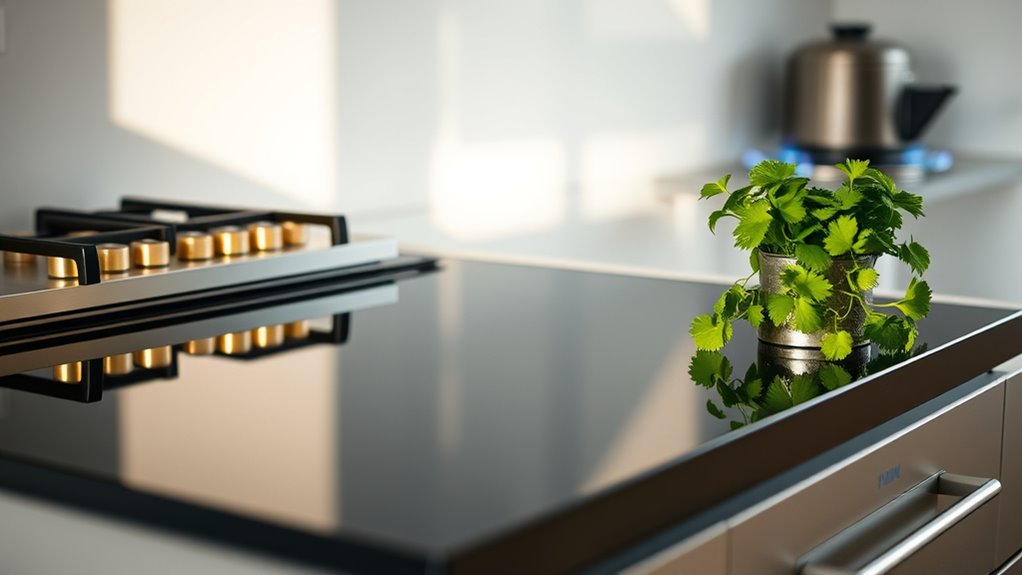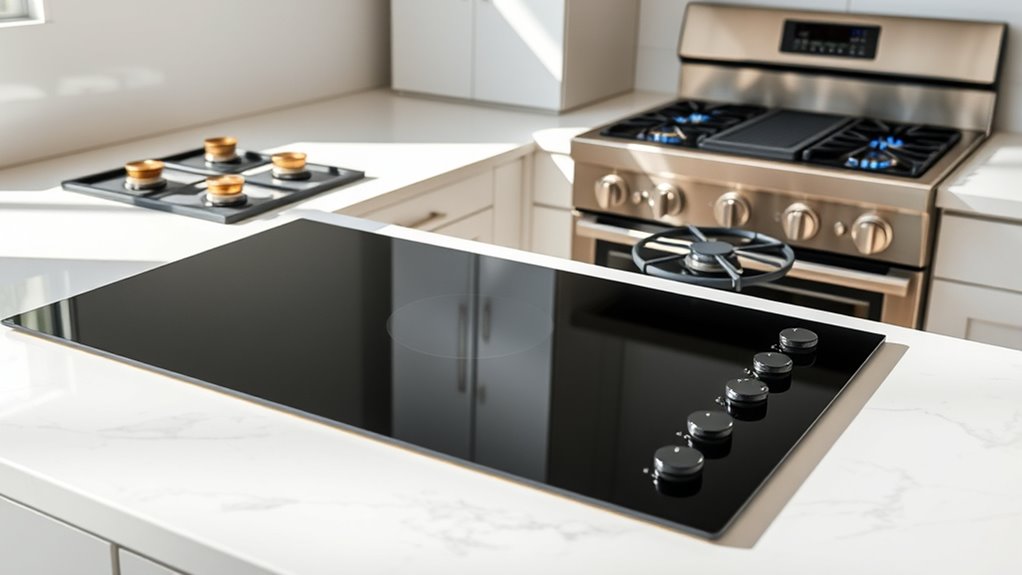Induction cooking is generally safer and more eco-friendly than gas, as it heats cookware directly with electromagnetic fields, offering quick, precise control while keeping surfaces cooler and reducing burn risks. It doesn’t produce indoor pollutants like carbon monoxide or nitrogen dioxide, making it better for indoor air quality. Plus, because it’s more energy-efficient and uses electricity, it supports greener living. Keep exploring to discover how these differences can transform your kitchen experience.
Key Takeaways
- Induction stoves heat directly through electromagnetic fields, offering faster, more precise, and safer cooking with minimal burn risk.
- Induction surfaces stay cooler and eliminate open flames, reducing fire hazards and making them safer for households with children or pets.
- Using electricity efficiently, induction reduces indoor pollutants and greenhouse gas emissions compared to gas stoves.
- Gas stoves emit combustion byproducts like carbon monoxide and nitrogen dioxide, impacting indoor air quality and health.
- The choice depends on safety priorities, environmental values, and cooking preferences, with induction being the greener and safer option overall.

Are you trying to decide between induction and gas for your kitchen? Choosing the right cooktop isn’t just about style or convenience; it’s about safety, energy efficiency, and environmental impact. Both options have their perks, but understanding how they differ can help you make the best decision for your home and health.
Induction cooktops use electromagnetic fields to heat pots and pans directly. This means heat is generated only where the cookware touches the surface, leading to faster and more precise temperature control. When you turn on an induction stove, you get immediate heat, and when you turn it off, the surface cools rapidly. This minimizes the risk of burns and accidental fires, making induction generally safer to use, especially if you have children or pets around. Plus, since the surface stays cooler, you won’t burn yourself if you accidentally brush against it. It’s also more energy-efficient because less heat is lost to the environment, which means it consumes less electricity over time.
Induction cooktops heat cookware directly, offering faster, safer, and more energy-efficient cooking with rapid cooling and precise control.
In contrast, gas stoves burn natural gas or propane to produce open flames. This method allows instant heat adjustment, which many chefs prefer for its responsiveness. However, open flames pose safety concerns: the risk of gas leaks, accidental fires, and burns. You need to be vigilant about turning off the gas completely and ensuring proper ventilation, as gas fumes can be hazardous to your health. Gas stoves also release combustion byproducts into your kitchen, including carbon monoxide and nitrogen dioxide, which can impact indoor air quality. From an environmental perspective, gas is a fossil fuel, contributing to greenhouse gas emissions and climate change, especially if your home relies on natural gas from non-renewable sources.
When considering safety and environmental impact, induction clearly has advantages. It’s safer because there’s no open flame and the surface stays cooler, reducing the chance of burns or fires. It’s greener because it uses electricity more efficiently and doesn’t emit indoor pollutants. On the other hand, if you’re a professional chef or someone who appreciates precise flame control, gas might appeal more, despite its safety and environmental concerns. However, for everyday home use, especially if safety and eco-friendliness matter to you, induction offers a compelling choice.
Ultimately, your decision depends on your priorities. If safety, energy efficiency, and reducing your carbon footprint are top concerns, induction is the smarter option. But if you value the traditional cooking experience and immediate heat control, gas still holds appeal. Knowing these differences helps you choose a kitchen setup that aligns with your lifestyle and values.
Frequently Asked Questions
How Does Induction Cooking Impact Indoor Air Quality?
Induction cooking improves indoor air quality because it doesn’t produce combustion byproducts like nitrogen dioxide or carbon monoxide, which are common with gas stoves. You won’t deal with smoke, fumes, or odors, making your kitchen healthier. Plus, since it heats cookware directly through electromagnetic fields, it’s more efficient and cleaner overall. This means a safer, fresher environment for you and your family while cooking.
Are There Specific Cookware Requirements for Induction Stoves?
Think of induction cookware as a key that unlocks the stove’s power. You need pots and pans with magnetic bottoms, usually made of cast iron or magnetic stainless steel, to work efficiently. Avoid non-magnetic materials like glass or aluminum unless they have a special magnetic layer. Ensuring your cookware is compatible guarantees safe, quick heating, and energy efficiency, giving you full control over your cooking experience.
What Are the Long-Term Cost Differences Between Induction and Gas?
You’ll likely spend less on energy with induction over time, thanks to its efficiency and faster heating. While induction stoves may cost more upfront, they save you money on utility bills in the long run. Gas stoves tend to have lower initial costs but can cost more in fuel and maintenance. Overall, induction offers better savings and fewer ongoing expenses, making it a more economical choice over time.
Can Induction Stoves Be Used During a Power Outage?
While induction stoves offer quick, efficient cooking, they rely on electricity, so you can’t use them during a power outage. Think of it as needing a steady supply of energy to keep things running smoothly. When the lights go out, your induction stove won’t activate, so it’s wise to have a backup plan. Consider a portable gas stove or other manual options to keep cooking during those times.
How Does Energy Efficiency Compare Over the Lifespan of Both Types?
Over their lifespan, induction stoves generally prove more energy-efficient than gas stoves. You use less energy because induction heats cookware directly, reducing heat loss. Gas stoves waste more energy through open flames and heat escape. Although induction stoves might have higher upfront costs, their efficiency saves you money on energy bills over time. Plus, they heat faster and respond quickly, making cooking more convenient and eco-friendly.
Conclusion
When choosing between induction and gas, safety and eco-friendliness tip the scales in favor of induction. Did you know that induction cooktops are 20% more energy-efficient than gas? Plus, they stay cooler, reducing fire risk. Making the switch not only protects your home and family but also helps the environment. So, consider going induction for a safer, greener kitchen—your health and the planet will thank you.









